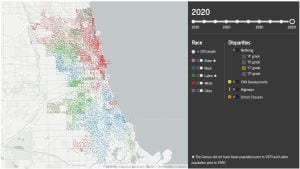From Garfield to Wilson: Chicago’s (In)visible Divisions
Author: Santiago Segovia
Program of Study: Master of Public Policy (MPP), Harris School of Public Policy (HAR)

(Source: https://interactive.wttw.com/firsthand/segregation/mapping-chicago-racial-segregation)
Description: This podcast addresses segregation in Chicago, from the most obvious way, which is how the city and its neighborhoods are distributed, to a more subtle kind, which directly affects people’s lives, jobs, and opportunities.
Listen here:
Transcript (provided by author):
Intro:
Welcome to the ELI’s Finding Chicago Global Perspectives Podcast Series for AEPP 2022. I’m your host, Santiago Segovia, and I’m currently enrolled in the University of Chicago’s Harris School of Public Policy. Today we will be discussing about segregation, from the most obvious way, which is how the city of Chicago and its neighborhoods are distributed, to a more subtle kind, which directly affects people’s lives, jobs, and opportunities.
Background:
As part of the exploration of the city, some friends and I were headed to Uptown from Hyde Park. Even though is not an entire trip from South to North, it covers around three quarters of Chicago, which is a great experience to get a sense of other parts of the city.
While planning our route, we noticed that from the university was quite simple to go to Uptown using public transportation. First, a shuttle would leave us at Garfield Station and from there the red line train would take us north to Wilson Station. It was a 60-minute ride, and although it is a relatively long time, it was definitely not a dull trip.
What struck me at the very beginning was how fast the landscape changed when you left campus and begin to head west: the transition from 19th century gothic architecture to nearly similar buildings not higher than five stories was intriguing. Then, as you get into the station, the first thing you notice is how loud it is, which comes as no surprise since it is in the middle of a highway. The colors are grey, and there was trash all over the rails.
While the train was going north you could see how the landscape began to change as well as the people who boarded the train car. From the fans supporting the White Sox at the Guaranteed Rate Field stop, also known as Comiskey Park by the locals, to the art piece located in the not-so-long-ago-rebuilt Wilson Station, this got me thinking about how segregation came to exist in the city, how evident it is, and even more how it is affecting those segregated.
Broader Issues:
There are many different aspects in which people segregated are affected, but I want to focus on a particular example: housing. According to the 2020 US Census, the people of Chicago are 31.4% White, 29.9% Latino, 28.7% Black, and 6.9% Asian. This speaks about the diversity of the city and could be an explanation of the city’s success in many aspects. However, when you breakdown that distribution into neighborhoods you could identify a clear pattern where white people is mainly located in the center and north part of the city, Latinos are all around the west side and black people are congregated in the south.
This distribution has not always been like this. For a long time, Chicago represented a step up for many people, in particular, African Americans. After the Great Migration, in 1930 there were approximately 230,000 Black people in Chicago, accounting for nearly 7% of the city’s population. Thirty years later, there were 810,000 Black Chicagoans, who made up nearly 23% of Chicago’s population, according to census data.
At the time, the increase in black population caused that the city enacted some regulations, or covenants, that prevented properties in certain areas from being sold to not Caucasian population. These were outlawed in 1968 with the Fair Housing Act, however, its damage was very significant. A 2017 report by the Metropolitan Planning Council and Urban Institute analyzed how Chicago compares with less segregated cities, measuring income, life expectancy, college completion, and homicides. The study determined that the divide between White, Black, and Latino Chicagoans costed the city $4.4 billion in lost income and contributed to hundreds of murders.
Conclusion:
As a difficult problem as it is, there is no simple solution, so what can be done to reduce the divisions in the city? From a public policy perspective, one first step has already been taken. In 2019, the city elected Lori Lightfoot as Mayor, the first African American woman to hold the office. According to an article from WTTW, Lightfoot has worked to reduce residential segregation by expanding the city’s support for affordable housing in every area of the city and has supported policies that seek to use city funds to build and renovate homes that low- and moderate-income Black and Latino Chicagoans can afford.
It is appropriate that people who understand the communities’ struggles have a say in which direction the city should move. Furthermore, a middle point between status-quo and gentrification could be to brought quality jobs for middle- or low-income neighborhoods. In this sense, the people already in a community could benefit from new opportunities, which ultimately breaks the burden that economic disadvantages could have in households, specially, those segregated.
Thank you for listening to the ELI’s Finding Chicago Global Perspectives Podcast Series for AEPP 2022. I’m your host, Santiago Segovia, and I hope you enjoyed my talk. If you want to learn more about the topic, visit the provided websites. Goodbye!
Sources:
Great Migration: https://newsroom.ucla.edu/stories/understanding-the-great-migration-through-an-economic-lens
Chicago’s Awful Divide: https://www.theatlantic.com/business/archive/2018/03/chicago-segregation-poverty/556649/
Housing Segregation: https://www.chicagomag.com/city-life/March-2017/Why-Is-Chicago-So-Segregated/
Decline in Manufacturing Employment: https://stateofracialjusticechicago.com/
2020 US Census Results for Chicago: https://www.chicagotribune.com/politics/ct-census-2020-chicago-illinois-20210812-pdmlgrdrsbaqnlrwl4etgd2y7a-story.html
Metropolitan Planning Council Report: https://news.wttw.com/sites/default/files/article/file-attachments/mpc_cost_of_segregation_web_EMBARGOED.pdf
Divergent Gentrification: https://journals.sagepub.com/doi/abs/10.1177/0003122414535774
Lori Lightfoot Election: https://news.wttw.com/2021/05/20/lightfoot-touts-accomplishments-2nd-anniversary-office-critical-tests-approach
Leave a Reply
You must be logged in to post a comment.